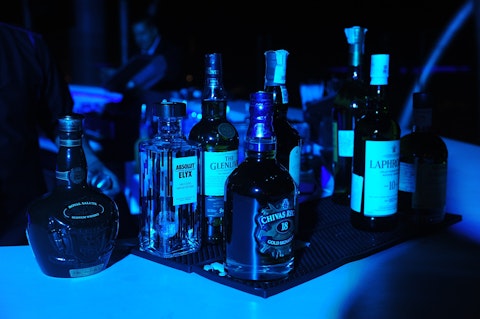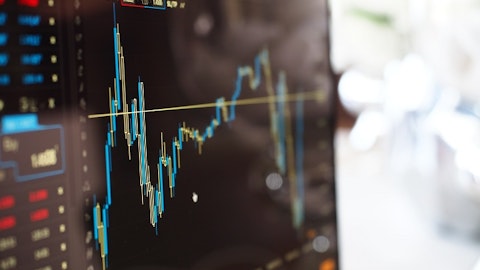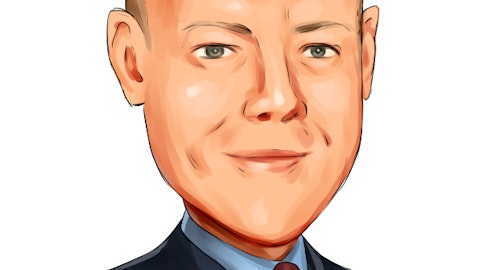In this article, we are going to discuss the 17 countries with the highest percentage of non-drinkers. You can skip our detailed analysis of the global alcohol industry, and the opportunities for non-alcoholic beverages in countries with a low prevalence of alcohol, and go directly to 5 Countries with the Highest Percentage of Non-Drinkers.
Globally, an estimated 35% of men are non-drinkers, while the rate for women is 55%. Alcohol has been outlawed in several countries today, in part or as a whole. All of these countries have a majority Muslim population and have governments that adhere to some form of Islamic law, known as Sharia. In the Islamic religion, two of the most significant prohibitions are eating pork and drinking alcohol. There are about 14 countries that have outlawed alcohol to some degree.
The Global Alcohol Industry:
In 2019, the global alcohol consumption, measured in liters of pure alcohol per person of 15 years of age or older, was 5.5 liters, which is a 4.7% relative decrease from 5.7 liters in 2010.
As we mentioned in our article – Top 20 Alcohol Drinking Countries in the World – the global alcoholic beverages market size was valued at $1.62 trillion in 2021, and the market is projected to reach $2 trillion by 2031, with a CAGR of 2.2% in the forecast period concluding in 2031.
Opportunities for Non-Alcoholic Beverages:
The low prevalence of alcohol in several Muslim-majority countries leads people to look elsewhere to quench their thirst, presenting opportunities to other non-alcoholic drinks. While the low- and no-alcohol trend is taking off in the Western world, another region which holds opportunities for this sector is the Middle East, where alcohol is banned in many countries. In 2019, Saudi Arabia was recorded to have the sixth-largest global market for alcohol-free beer consumption.
Several booze companies have hopped on the zero-alcohol bandwagon, and are now offering products with all of the taste and none of the booze. Budweiser Zero was launched in 2020 by Anheuser-Busch InBev SA/NV (NYSE:BUD) as the company’s first non-alcoholic beer, setting itself up as the industry standard. Anheuser-Busch InBev SA/NV (NYSE:BUD) also reportedly bought the rights to supply the FIFA World Cup for $75 million exclusively last year.
As the sale of alcohol is strictly controlled in Qatar, Bud Zero ended up being the only brew available at the stadiums during the whole event. Last month, Anheuser-Busch InBev SA/NV (NYSE:BUD) announced plans to invest $34 million in its Belgian breweries to help expand its portfolio of non-alcoholic beers, improve bottling capacity, and optimize a new non-alcoholic system used to make Corona Cero.
Anheuser-Busch InBev SA/NV (NYSE:BUD) is the Largest Beer Producer in the World but the company is facing some headwinds in the American market after the recent controversy regarding its best-selling brand Bud Light, which resulted in the iconic brand losing its crown as the Top-Selling Beer in America. Although, as we mentioned in our article – 20 Countries that Drink the Most Beer per Capita – billionaire Bill Gates’ portfolio managers decided to initiate a $96 million position in the firm during the second quarter.
Broyhill Asset Management said the following about Anheuser-Busch InBev SA/NV (NYSE:BUD) in its second quarter 2023 investor letter:
“The largest detractors to performance over the quarter were First Horizon Corp (FHN), Anheuser-Busch InBev SA/NV (NYSE:BUD), and Bayer (BAYRY). Problems at Anheuser Busch InBev began on April 1 with Dylan Mulvaney’s social media post, which ignited a fiery backlash amongst Bud Light customers across ‘Merica. With volumes down sharply, and competitors gaining share at BUD’s expense, operational deleveraging is set to weigh heavily on US margins amid peak demand pressure in the second quarter. Despite severe US headwinds (second-quarter operating profit maybe half of last year’s levels), we still expect BUD to grow consolidated operating profit at a mid-single-digit rate for the full year. With current issues well understood and investor sentiment in the gutters, we see significant upside in a stock, which is approaching a double-digit FCF yield. With FX headwinds and rising input costs reversing course, increasing margins are likely to drive positive surprises into FY24 as continued deleveraging accrues more value to shareholders.”
Saudi Arabia also leads the Middle Eastern market in terms of its consumption of drinks from the The Coca Cola Company (NYSE:KO), with Palestine not far behind. The Coca Cola Company (NYSE:KO)’s dominance in the Saudi Market is also due, in part, to the company’s focus on product innovation and customer-oriented marketing. Over the past few years, the company has been investing heavily in new packaging that allows customers to customize their drinks to their taste preferences. The Coca Cola Company (NYSE:KO) now represents nearly 40% of all carbonated soft drink sales in the Middle East.
Sales of PepsiCo, Inc. (NASDAQ:PEP) have traditionally been stronger in the Middle East, due, in part, to an Arab league-imposed boycott on Coca-Cola, which began when the firm decided in 1968 to open a bottling plant in Israel. PepsiCo, Inc. (NASDAQ:PEP) has been focusing on innovation and sustainability in its operations in the region – the company introduced the ‘Dawah’ bottle in the Middle East to recycle 88% of the water used in its production process. PepsiCo, Inc. (NASDAQ:PEP) also introduced a new beverage package in the Saudi market that is easier to use, recyclable, and doesn’t require any water to consume.
Similarly, the energy drinks market in the Middle East is one of the most promising in the coming years. It is true that during the pandemic, sales volumes dropped considerably due to restrictions. However, a slight recovery can be observed from 2021 onwards, reaching 859 million liters in sales during the year, and expected to increase to 100 million liters by 2026. Monster Beverage Corporation (NASDAQ:MNST) is a popular name in the Middle East, with the company boasting a 6.5% share in the regional market.
Following the health-conscious approach of many countries – including in the Middle East – to reduce obesity, Monster Beverage Corporation (NASDAQ:MNST) announced the launch of Monster Energy Zero Sugar earlier this year. According to the company, Monster Beverage Corporation (NASDAQ:MNST)’s team of scientists have concocted what is 100% Monster and 0% sugar. Primed with 160 mg of caffeine – like its predecessor – Monster Energy Zero Sugar helps fight fatigue, and improve mental performance and focus.
With that said, here are the Countries with the Highest Proportion of Non-Drinkers.

Pixabay/Public Domain
Methodology:
To collect data for this article, we have referred to the Global Health Observatory of the World Health Organization, looking for Countries with the Highest Percentage of Lifetime Alcohol Abstainers. Lifetime abstinence is defined as the proportion of adults (15+ years) in a given population who have not consumed any alcohol during their lifetime.
If you also wish to read about countries with the highest rate of alcohol-use disorder, here are the 20 Countries with Highest Rates of Alcoholism.
17. Comoros
Percentage of Non-Drinkers: 93.3%
The Comoros is a volcanic archipelago off Africa’s east coast, in the warm Indian Ocean waters of the Mozambique channel. Although alcoholic beverages are available in certain parts of the country (notably the large Volo-Volo market in the national capital Moroni), the public consumption of alcohol is generally frowned upon in the islands, as over 95% of the country’s population are devout Sunni Muslims. Alcohol is also served in a few bars and restaurants though they tend to be expensive.
16. Saudi Arabia
Percentage of Non-Drinkers: 93.4%
It should come as no surprise that alcohol is not exactly the most popular drink in the birthplace of Islam. Alcohol consumption, import, brewing, and selling is completely banned in Saudi Arabia.
However, non-alcoholic beer, wine, and spirits are gaining traction in the Middle Eastern country, in part due to an increasingly well-traveled consumer base. Saudi Champagne – a mix of fruit and soda water that can easily be made at home – is a popular drink in the country.
15. Algeria
Percentage of Non-Drinkers: 93.5%
Due to strong conservative Islamic beliefs, alcoholic consumption is frowned upon throughout most of North Africa. Nevertheless, large exceptions are made for visiting tourists. If you wish to drink alcohol in Algeria, there are some options to drink in restaurants, bars, hotels, and private homes. However, it’s still illegal to drink publicly in the country.
Beer is the most popular alcoholic beverage in Algeria, accounting for 57% of the recorded alcohol consumption.
Algeria ranks among the countries with the highest rate of alcohol abstinence.
14. Iraq
Percentage of Non-Drinkers: 93.8%
Iraqi attitudes towards alcohol have certainly had their ups and downs, from the relative ease of availability and acceptance in society in the mid-20th century to the Iraqi Parliament’s decision to outright ban the bottle in 2016.
In February, the Iraqi government published the long-proposed legislation banning the import of alcoholic beverages into the country, no doubt including Saddam’s beloved Johnny Walker Black Label.
13. Jordan
Percentage of Non-Drinkers: 93.9%
Although public displays of drunkenness are frowned upon, drinking alcohol in Jordan is accepted as long as it is done in moderation. Some restaurants will serve alcoholic beverages and there are a number of bars in Amman.
Amstel – owned by Heineken N.V. – remains the most consumed beer in the country with a 90% Muslim population.
12. Egypt
Percentage of Non-Drinkers: 94.3%
As Egypt is a majority Muslim country, many locals abstain from alcohol completely. However, it is possible to find liquor stores and bars in some upmarket neighborhoods, and many hotels and resorts serve alcohol.
Beer is the most popular beverage in the North African country, accounting for 54% of all alcohol consumption. Stella Lager – owned by Heineken N.V. since 2002 – is the most popular beer brand in Egypt.
Egypt ranks 12th among countries with the highest percentage of non-drinkers.
11. Morocco
Percentage of Non-Drinkers: 94.6%
The general act of consuming alcohol is not illegal in Morocco and you can find all sorts of alcoholic beverages all over the country. They even produce their own beers, wines, and liquors. However, where and how you consume alcohol is what lawmakers and their enforcers care about.
According to the ‘2021 Financial Law Implementation’ report, Morocco had collected a total of $86 million from import taxes on alcohol and wine, while the import taxes on beer accumulated $106 million for the national kitty.
10. Sudan
Percentage of Non-Drinkers: 95.2%
For several decades, locally made alcoholic beverages and locally cultivated cannabis have been the two main substances of use among certain groups in Sudan. Alcohol, although it has been prohibited by Sharia laws since 1983, is still illicitly used in many parts of the country.
However, in 2020, Sudan legalized the consumption of alcohol by non-Muslims, which make up 3% of the north African country’s total population.
Sudan ranks among the top 10 countries with the highest percentage of people who don’t drink alcohol.
9. Iran
Percentage of Non-Drinkers: 96%
Alcohol has been illegal for Muslim Iranian citizens since the establishment of the Islamic Republic government in 1979. Most consumers drink homemade alcoholic beverages in the country.
However, the strong public demand benefits the illegal multibillion-dollar business of importing alcoholic beverages and facilitating their production inside Iran.
8. Pakistan
Percentage of Non-Drinkers: 96.5%
Alcohol is largely prohibited for Muslims in Pakistan, but this doesn’t stop a black market from ensuring the supply of illicit liquor. Murree Brewery Company Limited – Pakistan’s largest and oldest producer of alcoholic products – is one of the most successful companies on the Pakistan Stock Exchange.
Due to the social stigma it faces in the country, the brewery does not advertise and keeps a low profile. However, during the height of the pandemic, the company was able to somewhat improve its public image by producing 10,000 gallons of ethanol-based hand sanitizer.
Pakistan ranks 8th in our list of countries with the highest percentage of non-drinkers.
7. Solomon Islands
Percentage of Non-Drinkers: 97.1%
In the Solomon Islands, illegal liquor known as Kwaso is distilled and widely consumed. It is often of low quality and is thought to have caused death, blindness, and several health problems.
6. Syria
Percentage of Non-Drinkers: 97.7%
Alcohol is not banned in Syria as it is in some Muslim countries. Nor is it reserved for the upper class elite or religious minorities. Syria’s constitution uses Islamic jurisprudence as a primary source of law, but the Baathist regime has kept alcohol legal, available, and cheap.
The Middle Eastern country has long produced its own alcoholic beverages, from beer to wine to the anise-based Arak. The leading brands in the Syrian beer market are Almaza, Heineken, and Al-Rayess.
Syria ranks 6th among countries with the highest percentage of alcohol abstainers.
Click to continue reading and see the 5 Countries with the Highest Percentage of Non-Drinkers.
Suggested Articles:
- Vodka Consumption by Country: Top 20 Countries
- Top 20 Oldest Breweries in America
- 20 Cities with the Most Bars per Capita in the World
Disclosure: None. 17 Countries with the Highest Percentage of Non-Drinkers is originally published on Insider Monkey.





